AT&T Corporation
 Final logo, used from 2015 to 2024 | |
 AT&T Corporation's former headquarters at550 Madison AvenueinNew York City | |
| Formerly | American Telephone and Telegraph Company (1885–1994) |
|---|---|
| Company type | Public |
| NYSE:T | |
| Industry | Telecommunications |
| Predecessor | American Bell |
| Founded | March 3, 1885 New York City, United States[1] |
| Founder | Theodore Newton Vail[2][3] |
| Defunct | May 1, 2024 |
| Fate | Dissolved |
| Successor | AT&T Inc. |
| Headquarters | , United States |
Area served | United States |
| Products | |
| Parent | American Bell(1885–1899) AT&T(2005-2024) |
| Subsidiaries | AT&T Communications |
AT&T Corporation,commonly referred to asAT&T,an abbreviation for its former name, theAmerican Telephone and Telegraph Company,was an Americantelecommunicationscompany that provided voice, video, data, and Internet telecommunications and professional services to businesses, consumers, and government agencies.
During theBell System's long history, AT&T was at times the world's largest telephone company, the world's largest cable television operator, and a regulated monopoly. At its peak in the 1950s and 1960s, it employed one million people and its revenue ranged between US$3 billion in 1950[4]($41.3 billion in present-day terms[5]) and $12 billion in 1966[6]($117 billion in present-day terms[5]).
In 2005, AT&T was acquired by "Baby Bell"and former subsidiary SBC Communications for more than $16 billion ($25 billion in present-day terms[5]). SBC then changed its name toAT&T Inc.,with AT&T Corporation continuing to exist as along distancesubsidiaryuntil its dissolution on May 1, 2024.[7]
History
[edit]Origins
[edit]

AT&T started withBell Patent Association,a legal entity established in 1874 to protect the patent rights ofAlexander Graham Bellafter he invented the telephone system. Originally a verbal agreement, it was formalized in writing in 1875 asBell Telephone Company.[8][9]
In 1880 the management of American Bell had created what would becomeAT&T Long Lines.The project was the first of its kind to create a nationwide long-distance network with a commercially viable cost-structure. The project was formally incorporated in New York as a separate company namedAmerican Telephone and Telegraph Companyon March 3, 1885. Originating in New York City, its long-distance telephone network reachedChicago, Illinois,in 1892,[10]with its multitudes of local exchanges continuing to stretch further and further yearly, eventually creating a continent-wide telephone system. On December 30, 1899, the assets of American Bell were transferred into its subsidiary American Telephone and Telegraph Company (formerlyAT&T Long Lines); this was becauseMassachusettscorporate laws were very restrictive, and limited capitalization to ten million dollars, forestalling American Bell's further growth. With this assets transfer at the very end of the 19th century, AT&T became the parent of both American Bell and theBell System.[11]
AT&T was involved mainly in the telephone business and, although it was a partner withRCA,was reluctant to see radio grow because such growth might diminish the demand for wired services. It established stationWEAFin New York as what was termed atoll station.AT&T could provide no programming, but anyone who wished to broadcast a message could pay a "toll" to AT&T and then air the message publicly. The original studio was the size of a telephone booth. The idea, however, did not take hold, because people would pay to broadcast messages only if they were sure that someone was listening. As a result, WEAF began broadcasting entertainment material, drawing amateur talent found among its employees. Opposition to AT&T's expansion into radio and an agreement with theNational Broadcasting Companyto lease long-distance lines for their broadcasts resulted in the sale of the station and its developing network of affiliates to NBC.[12]
Monopoly
[edit]Throughout most of the 20th century, AT&T held a semi-monopoly on phone service in the United States and Canada through a network of companies called theBell System.At this time, the company was nicknamedMa Bell.
On April 30, 1907,Theodore Newton Vailbecame President of AT&T.[13][14]Vail believed in the superiority of one phone system and AT&T adopted the slogan "One Policy, One System, Universal Service."[13][14]This would be the company's philosophy for the next 70 years.[14]
Under Vail, AT&T began buying up many of the smaller telephone companies includingWestern Union telegraph.[13][14]These actions brought unwanted attention from antitrust regulators. Anxious to avoid action from governmentantitrustsuits, AT&T and the federal government entered into an agreement known as theKingsbury Commitment.[13][14]In the Kingsbury Commitment, AT&T and the government reached an agreement that allowed AT&T to continue operating as a telephone monopoly, subject to certain conditions, including divesting its interest in Western Union. While AT&T periodically faced scrutiny from regulators, this state of affairs continued until the company's breakup in 1984.
Undersea communications and operations
[edit]AT&T had a domestic and global presence in laying the infrastructure of undersea routes for telecommunications. In 1950, the U.S. Navy commissioned a network of undersea surveillance cables for foreign submarine detection. AT&T was probably, according to internal employees, involved in this Sound Surveillance System (SOSUS). After completion, AT&T began commercial operations in cable laying for communications in 1955.[15]The implementation of cables assured local and long-distance telephone or data services would provide revenue for the company.[16]AT&T Long Lineswas one of the divisions responsible for the cable-laying and maintaining of Long Lines' undersea cables.[17]Western Electricwas the manufacturing company responsible for production and supply of undersea coaxial equipment and later, fiber cables. Equipment such as repeaters was manufactured in Clark, New Jersey and coaxial cable was manufactured in Baltimore, Maryland.[18]Also,Bell Labswas responsible for the innovations of products[19]or technologies in cabling in transmission by undersea systems.[20]In 1955, the first trans-Atlantic telephone undersea cable,TAT-1,from North America to Europe was installed by AT&T. This installation allowed 48 telephone circuits to be used for long-distance calling.[21]When partnering with other global Telecommunications companies, such as the French Cables de Lyon and GermanFelten & Guilleaume,Bell Labs provided the specification and inspection of non Bell System cable for networks such as theTAT-2.[18]By the continuous undersea network installations, AT&T was a globally technology leader with the 1970 installedTAT-5and the 1975 installedTAT-6,achieving 720 channels and then 4000 channels for transmitting voice or data.[18]Prior to 1963, AT&T had to charter oceanic ships, such as theCS Monarch (1945)for installations. AT&T purchasedCS Long Linesin 1961 and operated it with several cable laying ships that would provide, either the laying or repair of cabling under the subsidiary, Transoceanic Cable Ship Company. After the break-up, AT&T operated their ships under a subsidiary called AT&T Submarine Systems Inc, based in Morristown, New Jersey, until they sold six ships to Tyco International Ltd in 1997 for $850 million.[22]AT&T continued to maintain their communication building facilities. Here is a list of the cable laying-ship fleet:
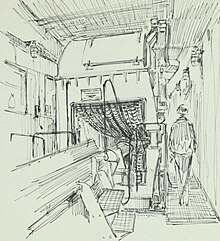
- CSLidiv(Decommissioned 1955) Built for AT&T Corp. for New York Telephone Company use. Decommissioned in 1955 and the CS Cable Queen was the replacement.[23]
- CSCable Queen(Built 1951–1952) Built for AT&T Corp. for the Bell System usage by New York Telephone Company. A 65-foot small-scale underwater telephone cable-laying vessel. Decommissioned after 1989 with over 100,000 miles of cable laying.[24]
- CSSalernum/Charles L. Brown(Built 1954) Built in Italy and named CS Salernum. Dimensions were length as 339.6 ft, breadth as 41.0 ft, depth as 18.5 ft, and gross tonnage at 2789. Purchased by AT&T Corp. through its subsidiary, Transoceanic Cableship Co., in 1984. Sold by AT&T in 1997 to Tyco International in the AT&T Submarine Systems fleet purchases. The wreck became an article reef in the Dutch Caribbean island, Sint Eustatius.[25]

- CSLong Lines(Built 1961–1963) Built for AT&T Corp. for the 1961 launching, but cable laying assignments began in 1963. The $19 million vessel was 511 feet length and 11,300-tons. Performed the laying of the first trans-Pacific telephone cable, known as TRANSPAC-1 (TPC-1) in 1964. and the first trans-Pacific fiber cable, known as TPC 3.[26]Sold in 1997 to Tyco International.[27]Scrapped in 2003.[26]
- CSLink(Built 1990s) Owned by Transoceanic Cable Ship Co., a subsidiary of the United States–based telephone company, AT&T Corp.[28]
- CSGlobal Sentinel(Built 1992) Maiden voyage from shipyard to Honolulu was February 1992. The 479-foot vessel equipped with bow thrusters, began cable laying operations in early 1992. Owned by Transoceanic Cable Ship Co., a subsidiary of the United States telephone company, AT&T Corp.[29]
- CSGlobal Mariner(Built 1992) Built in Singapore. The 479-foot vessel was equipped with bow thrusters and had storage space for up to 4100 nautical miles of cable. Seafaring was done in December 1992 by Seafarers International Union crew. A SIU publication,Seafarers Log,indicated in January 1993 the vessel was the fifth cable ship of the AT&T Corp. fleet. It was a sister ship and identical to CS Global Sentinel. Owned by Transoceanic Cable Ship Co., the subsidiary of the United States AT&T telephone company.[30]
Between 1951 and 2000, AT&T was listed 73 times in cable laying operations for specific routes deployed.[31] The Cable ShipLong Lineshad 23 cable runs from 1963 to 1992, with the first deep-sea trial of optical fiber cable in 1982 leading to the consortium of countries and locations for theTAT-8fiber cable implementation of 1988.[32]
The Break-up
[edit]This sectionneeds additional citations forverification.(February 2021) |

The United States Justice Department opened the caseUnited States v. AT&Tin 1974. This was prompted by suspicion that AT&T was using monopoly profits from itsWestern Electricsubsidiary to subsidize the cost of its network, a violation of antitrust law.[33]A settlement to this case was finalized in 1982, leading to thedivision of the companyon January 1, 1984, into sevenRegional Bell Operating Companies,commonly known as Baby Bells. These companies were:
- Ameritech,acquired by SBC in 1999, now part of AT&T Inc.
- Bell Atlantic (nowVerizon Communications), which acquiredGTEin 2000
- BellSouth,acquired by AT&T Inc. in 2006
- NYNEX,acquired by Bell Atlantic in 1996, now part of Verizon Communications
- Pacific Telesis,acquired by SBC in 1997, now part of AT&T Inc.
- Southwestern Bell (later SBC, nowAT&T Inc.), which acquired AT&T Corp. in 2005
- US West,acquired byQwestin 2000, which in turn was acquired by CenturyLink (nowLumen Technologies) in 2011
| AT&T Corporation RBOCgrouped into "Baby Bells" split off in 1984 | |||||||||||||||||||||||||||||||||||||||||||||||||||||||||||||||||||||
| BellSouth | AT&T Corporation (non-LEC) | Ameritech | Pacific Telesis | Southwestern Bell (laterSBC Communications) | Bell Atlantic | NYNEX | US West | ||||||||||||||||||||||||||||||||||||||||||||||||||||||||||||||
| GTE (non-RBOCILEC) | Qwest(non-ILEC) | ||||||||||||||||||||||||||||||||||||||||||||||||||||||||||||||||||||
| Verizon | |||||||||||||||||||||||||||||||||||||||||||||||||||||||||||||||||||||
| AT&T (formerSBC) | |||||||||||||||||||||||||||||||||||||||||||||||||||||||||||||||||||||
| CenturyLink (non-RBOC ILEC) | |||||||||||||||||||||||||||||||||||||||||||||||||||||||||||||||||||||
| AT&T | Verizon | Lumen Technologies | |||||||||||||||||||||||||||||||||||||||||||||||||||||||||||||||||||
Post-breakup, the former parent company's main business was nowAT&T Communications Inc.,which focused on long-distance services, and with other non-RBOC activities.
AT&T acquiredNCR Corporationin 1991. AT&T announced in 1995 that it would split into three companies: a manufacturing/R&D company, a computer company, and a services company.NCR,Bell Labsand AT&T Technologies were to be spun off by 1997. In preparation for its spin-off, AT&T Technologies was renamedLucent Technologies.Lucent was completely spun off from AT&T in 1996.
Acquisition by SBC
[edit]On January 31, 2005, the "Baby Bell"company SBC Communications announced its plans to acquire"Ma Bell"AT&T Corp. for $16 billion. SBC announced in October 2005 that it would shed the" SBC "brand and take the more recognizable AT&T brand, along with the old AT&T's" T "NYSEticker symbol.
Merger approval concluded on November 18, 2005; SBC Communications began rebranding the following Monday, November 21 as "the new AT&T"and began trading under the" T "symbol on December 1. Present-day AT&T Inc. claims AT&T Corp.'s history as its own, but retains SBC's pre-2005 stock price history and corporate structure. As well, all SEC filings before 2005 are under SBC, not AT&T.
The AT&T headquarters buildings
[edit]From 1885 to 1910, AT&T was headquartered at 125 Milk Street in Boston. With its expansion it moved to New York City, to a headquarters on195 Broadway(close to what is now theWorld Trade Center site). The property originally belonged toWestern Union,of which AT&T held a controlling interest until 1913 when AT&T divested its interest as part of theKingsbury Commitment.[14]Construction of the current building began in 1912. Designed byWilliam Welles Bosworth,who played a significant role in designingKykuit,the Rockefeller mansion north ofTarrytown, New York,it was a modern steel structure clad top to bottom in a Greek-styled exterior, the three-story-high Ionic columns of Vermont granite forming eight registers over a Doric base.[34]The lobby of the AT&T Building was one of the most unusual ones of the era. Instead of a large double-high space, similar to the nearbyWoolworth Building,Bosworth designed what is called a "hypostyle hall", with full-bodied Doric columns modeled on the Parthenon, marking out a grid. Bosworth was seeking to coordinate the classical tradition with the requirements of a modern building. Columns were not merely the decorative elements they had become in the hands of other architects but created all the illusion of being real supports. Bosworth also designed the campus ofMITas well asTheodore N. Vail's mansion inMorristown, New Jersey.
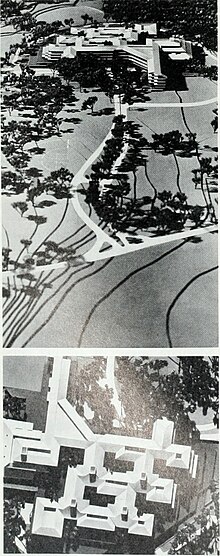

In 1978, AT&T commissioned a new building at550 Madison Avenue.This new AT&T Building was designed byPhilip Johnsonand quickly became an icon of the newPostmodernarchitectural style. The building was completed in 1984, the very year of the divestiture of the Bell System. The building proved to be too large for the post-divestiture corporation and in 1993, AT&T leased the building toSony,who then subsequently owned the building until it was sold in 2013.[35][36]

In 1969, AT&T began plans to construct an administration corporate complex in the suburbs. In early 1970, AT&T began purchases of land in the suburbs of New Jersey for this office complex and began construction in 1974. The award-winning architect,Vincent Kling,designed aFordism[37]style, luxurious "Pagoda"[38]campus layout and the construction firms: New York–based Walter Kidde andNewark, New Jersey–based Frank Briscoe, managed this joint venture construction project with Vollers Construction ofBranchburg, New Jersey,as the subcontractor. The 295 North Maple Avenue and Interstate 287 location ofBasking RidgeinBernards Township,New Jersey was completed in 1975 for the AT&T General Department offices. Employees began moving, in November 1975, to the seven inter-connected building complex using 28 acre of the property. The property had a 15-acre underground parking garage with spaces for 3,900 vehicles, and included a Class 1 licensed privatehelipad,a two-story cafeteria, a wood-burning fireplace, an indoor waterfall at the entrance lobby, and a seven-acre created lake for flood control. The entire property was 130 acre and cost $219 million to construct. Later, across the street from the complex, AT&T purchased additional land and established its Learning Center in 1985, at 300 North Maple Avenue, to become a 171 conference room inn. The AT&T Learning Center won the commercial property known as Somerset County's Land Development Award that year. In 1992, Basking Ridge location would become a corporate headquarters just before AT&T leased the New York City, 550 Madison Avenue building to Sony in 1993. The corporate statue, known as "Golden Boy"was moved in 1992, from the former New York City headquarters to this current New Jersey headquarters. In 1992, a corporate art consultant approached, artist sculptor,Elyn Zimmerman,to commission a 30-foot diameter project with fountain and seating area for the conference center courtyard gardens. In 1994, the project was completed and had one 34 ton granite boulder centered on top of the other boulders, which flowed water from the fountain designed by fountain engineer, Dr. Gerald Palevsky.[39]AT&T occupancy at the location peaked to 6,000 employees in its heyday before AT&T experienced competition and downsizing.

In October 2001, the Basking Ridge property was 140 acre with 2.6 million square feet and was placed for sale.[40]Basking Ridge employee occupancy, prior to the sale were approximately 3,200 employees. In April 2002,Pharmacia Corporationpurchased the complex for $210 million for their corporate headquarters from existingPeapack-Gladstone, New Jerseyheadquarters.[41]A short time afterwards, in 2005,Verizonpurchased the former complex, excluding the hotel/conference room building,[42]fromPfizerfor Verizon Wireless Headquarters and consolidation of employees from Manhattan as well as other nearby New Jersey building locations.[43]In 2007, Pfizer placed the North Maple Inn for sale. At the time, it was a four-diamond, certified hotel and conference center under IACC ( "International Association of Conference Centers" ) designation.[44]In 2015, Verizon performed a sale-leaseback agreement valued at $650.3 million on the complex with the address previously known as One Verizon Way.[45]In 2017, the 35 acre hotel/conference center was known as the Dolce Basking Ridge Hotel and sold for $30 million.[46]
Dissolution
[edit]On February 15, 2024, AT&T Inc. filed notice with the Kentucky Public Service Commission that it intends to make an internal structural change and merge AT&T Corp. into AT&T Enterprises, Inc., which will become alimited liability company.In a filing with theSouth Dakota Secretary of Statedated January 30, 2024, the reason given for the merger is thatNew Yorkstate law does not allow AT&T Corp. to be directly converted into an LLC.[47]Although acquired by SBC in 2005, AT&T Corp. has remained a separate entity within the corporate structure of AT&T Inc. The merger, said to create “greater operational efficiencies”, will end the existence of the nearly 140-year-old entity. The internal merger took effect on May 1, 2024.[48]
Divisions
[edit]AT&T, prior to its merger withSBC Communications,had three core companies:
AT&T Alascomsold service in Alaska.AT&T Communicationswas renamedAT&T Communications – East, Inc.and sold long-distance telephone service and operated as aCLECoutside of the borders of theBell Operating CompaniesthatAT&Towned. It has now been absorbed into AT&T Corp. and all but 4 of the original 22 subsidiaries that formed AT&T Communications continue to exist. The AT&T company had become too large and the government, wanting to prevent a monopoly forced AT&T to break up.AT&T Laboratorieshas been integrated intoAT&T Labs,formerly namedSBC Laboratories.
Nicknames and branding
[edit]AT&T was also known as "Ma Bell" and affectionately called "Mother" by phonephreaks.During some strikes by its employees, picketers would wear T-shirts reading, "Ma Bell is a real mother." Before the break-up, there was greater consumer recognition of the "Bell System" name, in comparison to the name AT&T. This prompted the company to launch an advertising campaign after the break-up to increase its name recognition. Spinoffs like theRegional Bell Operating CompaniesorRBOCs were often called "Baby Bells". Ironically, "Ma Bell" was acquired by one of its "Baby Bells",SBC Communications,in 2005.
The AT&T Globe Symbol,[49]the corporate logo designed bySaul Bassin 1983 and originally used byAT&T Information Systems,was created because part of theUnited States v. AT&Tsettlementrequired AT&T to relinquish all claims to the use ofBell Systemtrademarks. It has been nicknamed the "Death Star"in reference to the Death Star space station inStar Warswhich the logo resembles. In 1999 it was changed from the 12-line design to the 8-line design. Again in 2005 it was changed to the 3D transparent "marble" design created by Interbrand for use by the parent companyAT&T Inc.This name was also given to the iconicBell Labs facilityinHolmdel, New Jersey,now a multi-tenant office facility.[citation needed]
Notable buildings with the AT&T logo
[edit]- AT&T Huron Building,Cleveland
- AT&T Building,Nashville
- AT&T Building,Indianapolis
List of AT&T chief executive officers
[edit]The following is a list of the 16 CEOs of AT&T Corporation, from its incorporation in 1885 until its purchase by SBC Communications in 2005.[50]
| # | chief executive officer | Years in office | Title |
|---|---|---|---|
| 1 | 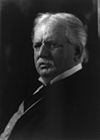 Theodore Newton Vail Theodore Newton Vail
|
1885–1887 | President |
| 2 | 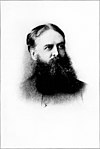 John E. Hudson John E. Hudson
|
1887–1900 | President |
| 3 |  Frederick Perry Fish Frederick Perry Fish
|
1901–1907 | President |
| 4 |  Theodore Newton Vail Theodore Newton Vail
|
1907–1919 | President |
| 5 | 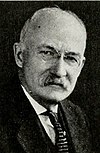 Harry Bates Thayer Harry Bates Thayer
|
1919–1925 | President |
| 6 |  Walter Sherman Gifford Walter Sherman Gifford
|
1925–1948 | President |
| 7 | Leroy A. Wilson | 1948–1951 | President |
| 8 | 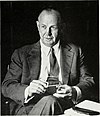 Cleo F. Craig Cleo F. Craig
|
1951–1956 | President |
| 9 | Frederick Kappel | 1956–1961 1961–1967 |
President Chairman |
| 10 | H. I. Romnes | 1967–1972 | Chairman |
| 11 | John D. deButts | 1972–1979 | Chairman |
| 12 | Charles L. Brown | 1979–1986 | Chairman |
| 13 | James E. Olson | 1986–1988 | Chairman |
| 14 | Robert Eugene Allen | 1988–1997 | Chairman |
| 15 | C. Michael Armstrong | 1997–2002 | Chairman |
| 16 | David Dorman | 2002–2005 | Chairman |
See also
[edit]- Bell Telephone Memorial,a monument sculpted by W.S. Allard, commemorating the invention of the telephone
- International Bell Telephone Company,sister company to American Bell Telephone, with its headquarters in Brussels, Belgium
References
[edit]Citations
[edit]- ^"Foreign Corporations".bsd.sos.mo.gov.Missouri Secretary of State.RetrievedMay 7,2024.
- ^Russell, Andrew L. (2014).Open Standards and the Digital Age: History, Ideology, and Networks.Cambridge University Press. p. 100.ISBN978-1-107-03919-3.
- ^Abate, Frank R., ed. (1999).The Oxford Desk Dictionary of People and Places.Oxford University Press. p. 386.ISBN0-19-513872-4.RetrievedMay 21,2024.
- ^"Annual Report 1950, American Telephone & Telegraph Company"(PDF).
- ^abc1634–1699:McCusker, J. J.(1997).How Much Is That in Real Money? A Historical Price Index for Use as a Deflator of Money Values in the Economy of the United States: Addenda et Corrigenda(PDF).American Antiquarian Society.1700–1799:McCusker, J. J.(1992).How Much Is That in Real Money? A Historical Price Index for Use as a Deflator of Money Values in the Economy of the United States(PDF).American Antiquarian Society.1800–present:Federal Reserve Bank of Minneapolis."Consumer Price Index (estimate) 1800–".RetrievedFebruary 29,2024.
- ^"Annual Report 1966, American Telephone & Telegraph Company"(PDF).
- ^McDonald, Laura (April 18, 2024)."Farewell to AT&T Corp".Levine, Blaszak, Block & Boothby, LLP.RetrievedMay 1,2024.
- ^Bruce 1990, p. 291.[full citation needed]
- ^Pizer 2009, pp. 120–124.Bruce 1990, p. 291[full citation needed]
- ^Bruce 1990.Bruce 1990, p. 291[full citation needed]
- ^Brooks 1976, p. 107.Bruce 1990, p. 291[full citation needed]
- ^Perry, S. D. (2004).A Consolidated History of Media(3rd ed.). Bloomington, IL: Epistelogic.[page needed]
- ^abcdThierer, Adam D. (1994)."Unnatural Monopoly: Critical Moments in the Development of the Bell System Monopoly"(PDF).Cato Journal.14(2).Cato Institute:267–285.Archived(PDF)from the original on April 27, 2019.RetrievedMay 15,2019.
- ^abcdef"AT&T Milestones in AT&T History".AT&T.Archived fromthe originalon September 28, 2008.RetrievedSeptember 17,2008.
- ^Brock, Joe."SPECIAL REPORT-Inside the subsea cable firm secretly helping America take on China".reuters.Reuters.RetrievedDecember 1,2023.
- ^Mills, Mike."Undersea Cables Carry Growing Rivers of Data".Washington Post.RetrievedDecember 1,2023.
- ^"Submarine Coaxial Cable Restoration".long.lines.net.Long Lines.RetrievedDecember 1,2023.
- ^abcKelly, Paul L.; Kaminow, Ivan P.; Agrawal, Govind P. (December 21, 2019)."Undersea Fiber Communication Systems (Optics and Photonics)".ebin.pub.EBIN.RetrievedDecember 1,2023.
- ^Haemmerle, Ed."1976 TAT-6".atlantic-cable.Atlantic Cable.RetrievedDecember 1,2023.
- ^Easton, Robert L."Undersea Cable Systems - A Survey or: Explanation to an Unknown Lady in Philadelphia".atlantic-cable.Atlantic Cable.RetrievedDecember 1,2023.
- ^Wagner, Eric."30,000 Feet Below: Connecting Continents from the Ocean Floor".about.att.AT&T.RetrievedDecember 1,2023.
- ^"AT&T sells cable ship division".tradewindsnews.TradeWinds. July 10, 1997.RetrievedDecember 1,2023.
- ^Glover, Bill."CS Cable Queen".atlantic-cable.History of the Atlantic Cable & Undersea Communications.RetrievedDecember 1,2023.
- ^Glover, Bill."CS Cable Queen".atlantic-cable.History of the Atlantic Cable & Undersea Communications.RetrievedDecember 1,2023.
- ^Mauric, Damien."Secret Scuba Spot: Charlie Brown Wreck in Statia".scubadiving.Padi.RetrievedDecember 1,2023.
- ^abSwinhoe, Dan."A brief history of cable ships".datacenterdynamics.datacenterdynamics.RetrievedDecember 1,2023.
- ^"C.S. LONG LINES - IMO 5421235".shipspotting.Ship Spotting.RetrievedDecember 1,2023.
- ^"Seafarers Bring Newest AT&T Cable Ship to States"(PDF).Seafarers Log.55(1): 3. January 1993.
- ^"Seafarers Sail Through a Year Of Military Operations, Legislation, New Vessels and Elections"(PDF).Seafarers Log.55(1): 14. January 1993.
- ^"Fifth AT&T Ship Joins Cable Fleet"(PDF).Seafarers Log.55(1): 3. January 1993.
- ^Glover, Bill."Cable Timeline: 1951-2000".atlantic-cable.Atlantic Cable.RetrievedDecember 1,2023.
- ^Glover, Bill."CS Long Lines".atlantic-cable.Atlantic Cable.RetrievedDecember 1,2023.
- ^Yurick, p. 7.Bruce 1990, p. 291[full citation needed]
- ^Jarzombek, Mark (2004).Designing MIT: Bosworth's New Tech.Boston: Northeastern University Press. pp. 65–68.ISBN1555536190.OCLC55124376.
- ^Popik, Barry (September 25, 2005)."Chippendale Building (SONY building)".The Big Apple.Archivedfrom the original on January 12, 2019.RetrievedDecember 6,2006.
- ^Stoler, Michael (September 8, 2005)."Fortune 100 Companies Capitalize on Record Prices".The Stoler Report.First American Title Insurance Company of New York. Archived fromthe originalon December 26, 2007.
- ^Kaika, Maria (July 2011)."Autistic Architecture: The Fall of the Icon and the Rise of the Serial Object of Architecture"(PDF).hummedia.manchester.ac.uk.Centre for Research on Socio-Cultural Change, The University of Manchester. p. 5.RetrievedDecember 21,2023.
- ^Kaika, Maria (July 2011)."Autistic Architecture: The Fall of the Icon and the Rise of the Serial Object of Architecture"(PDF).hummedia.manchester.ac.uk.Centre for Research on Socio-Cultural Change, The University of Manchester. p. 9.RetrievedDecember 21,2023.
- ^Zimmerman, Elyn."AT&T Headquarters 1994".elynzimmerman.Elyn Zimmerman.RetrievedDecember 21,2023.
- ^Peterson, Eric."Verizon Ready to Buy Former AT&T Campus".globest.ALM Global, LLC.RetrievedDecember 21,2023.
- ^Holusha, John (April 6, 2002)."Pharmaceutical Company to Buy AT&T Complex in New Jersey".The New York Times.RetrievedDecember 21,2023.
- ^"Former AT&T HQ Hitting the Market".siteselection.Conway Data, Inc. May 19, 2003.RetrievedDecember 21,2023.
- ^"Red carpet for Verizon; Bernards greets new owner of old AT&T headquarters".newjerseyhills.Bernardsville News. March 31, 2005.RetrievedDecember 21,2023.
- ^"North Maple Inn for Sale".hotelexecutive.March 2, 2007.RetrievedDecember 21,2023.
- ^Hutchinson, Dave (May 20, 2015)."Verizon sells Basking Ridge HQ for $650.3 million, but will stay put".nj.NJ Advance Media for nj.RetrievedDecember 21,2023.
- ^Tarrazi, Alexis (January 17, 2017)."Dolce Basking Ridge Hotel Sells for $30 Million".patch.RetrievedDecember 21,2023.
- ^Blessing, John.“Notification of Internal Corporate Restructuring of AT&T Corp. into AT&T Enterprises, LLC”.South Dakota Public Utilities Commission. Retrieved 22 April 2024.
- ^Tyler, John T."Notice of Merger of AT&T Corp. and AT&T Enterprises, Inc."Kentucky Public Service Commission. Retrieved 18 April 2024.
- ^Massey, David."Bell Logo History".Bell System Memorial.The Porticus Centre. Archived fromthe originalon September 30, 2011.
- ^Focusmagazine (internal AT&T company publication), sidebar titled "AT&T's chief executives", 1988
Sources
[edit]- Works cited
- Brock, Gerald W. (1981).The Telecommunications Industry The Dynamics Of Market Structure.Harvard Economic Studies. Cambridge, MA: Harvard University Press.ISBN978-0-674-87285-1.
- Brooks, John (1976).Telephone The First Hundred Years.Harper & Row.ISBN978-0-06-010540-2.
- "Milestones in AT&T History".AT&T.RetrievedDecember 14,2013.
External links
[edit]- AT&T(Archive)
- The short filmA CONTINENT IS BRIDGED(Reel 1 of 4,Reel 2 of 4,Reel 3 of 4,Reel 4 of 4) (1940) is available for free download at theInternet Archive
- American Telephone & Telegraph logos, adverts and historical telephone maps on theBaring archive Risks and Rewards website
- Historical AT&T Financial Documents
- AT&T Telephone Magazine: January/February 1972 VOL 51/NO 1 to November/December 1973 VOL 52/NO 5, 402 pages. Publication in a browsable PDF file.[1]
- AT&T
- Bell System
- Defunct telecommunications companies of the United States
- Telecommunications companies established in 1885
- Telecommunications companies disestablished in 2005
- Companies formerly listed on the New York Stock Exchange
- Telecommunications monopolies
- Companies based in Somerset County, New Jersey
